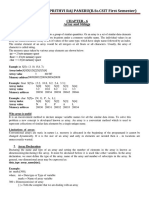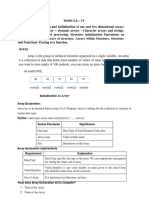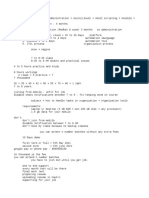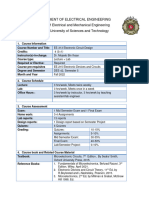chapter2_5
Uploaded by
hanhihd3095chapter2_5
Uploaded by
hanhihd3095Chapter 5
Pointers and Arrays
Contents
5.1. Concepts of pointers
5.2. Pointer declarations
5.3. Pointer operators
5.4. Concepts of arrays
5.5. One dimensional arrays
5.6. Operations on one dimensional arrays
5.7. Multi-dimensional arrays
5.1. Concepts of pointers
• Powerful, but difficult to master
• Simulate call-by-reference for functions
• Close relationship with arrays and strings
Pointers and Addresses
• One variable always has two properties:
• The address of the variable
• The value of the variable.
• Example:
int i, j;
i = 3;
j = i;
A pointer is a variable that contains the address of a variable
Directly and indirectly referencing a variable
5.2. Pointer declaration
• A pointer is a special type of variable that can hold an
address
• Pointer declaration
type * name ;
• Example:
1. #include <stdio.h>
2. main()
3. {
4. int a=5;
5. int *p=&a;
6. printf("%x %d", p,a);
7. }
Graphical representation of a pointer variable
Pointer Operators
& (address operator)
• Returns address of operand
int y = 5;
int *yPtr;
yPtr = &y; /* yPtr gets address of y */
yPtr “points to” y
Pointer Operators
* (indirection/dereferencing operator)
• Returns a synonym/alias of what its operand points to
• *yptr returns y (because yptr points to y)
• * can be used for assignment
• Returns alias to an object
*yptr = 7; /* changes y to 7 */
• Dereferenced pointer (operand of *) must be an lvalue (no
constants)
Example
If aPtr points to a, then &a and
aPtr have the same value.
a and *aPtr have the same value
&*aPtr and *&aPtr have the same value
Result of the program on previous slide
The address of a is 0012FF7C
The value of aPtr is 0012FF7C
The value of a is 7
The value of *aPtr is 7
Showing that * and & are complements of each other.
&*aPtr = 0012FF7C
*&aPtr = 0012FF7C
Arrays
• Problem solving often requires information be
viewed as a list or a matrix.
• C provides a mechanisms: Array structure
• One-dimensional or multidimensional
• Traditional and important because of legacy
libraries
• Restrictions on its use
Array Terminology
• An array is composed of elements
• Elements in an array have a common name
• The list as a whole is referenced through the
common name
• In the scope of the course elements of an array are
of the same type — the base type
• Elements of an array are referenced by subscripting
or indexing the common name
One dimensional array declaration
BaseType Id [ SizeExp ] ;
Type of Bracketed constant
values in expression
list Name indicating number
of list of elements in list
double X [ 100 ] ;
Restrictions
• Subscripts are denoted as expressions within
brackets: [ ]
• Base type can be any standard, library-defined, or
programmer - defined type
• The index type is integer and the index range must
be 0 ... n-1 where n is a programmer-defined
constant expression.
Examples of array declaration
• Suppose
const int N = 20;
const int M = 40;
const int MaxStringSize = 80;
const int MaxListSize = 1000;
• The following are all correct array declarations
int A[10]; // array of 10 ints
char B[MaxStringSize]; // array of 80 chars
double C[M*N]; // array of 800 floats
int Values[MaxListSize]; // array of 1000 ints
Rational D[N-15]; // array of 5 Rationals
int F[5]={0,1,2,3,4}
Subscripting
• Suppose
• int A[10]; // array of 10 ints A[0], … A[9]
• To access individual element must apply a subscript to list name A
• A subscript is a bracketed expression also known as the index
• First element of list has index 0
A[0]
• Second element of list has index 1, and so on
A[1]
• Last element has an index one less than the size of the list
A[9]
• Incorrect indexing is a common error (in several C compilers)
A[10] // OK in DevC
Basic Operations on one dimensional arrays
• Input data
• Print the list
• Find smallest (greatest) value, indexes of smallest
elements of the list
• Search the list with a key
• Sort the list in ascending (descending) order
• Insert an element
• Delete an element
18
Input data into an array
int A[10];
int n;//actual size of A
int i ;// control variable
//Input array size
do {
printf("Enter array size:");
scanf("%d",&n);
while (n<1||n>10) ;
//Input elements
for(i=0;i<n;i++)
printf("\nA[%d]=",i);// Remind the user to enter correct element
scanf("%d",&A[i]);
} }
}
19
Display an array
// List A of n elements has already been set
puts("\nYour List");
for(i=0;i<n;i++)
printf("%d ", A[i]);
Result of the program
21
Smallest Value
• Problem
• Find the smallest value in a list of integers
• Input
• a value indicating the number of elements and a list of
number
• Output
• Smallest value in the list
• Note
• List remains unchanged after finding the smallest value!
Necessary Information
• Information to be maintained
• Number of values in array
• Array with values to be inspected for smallest value
• Index of current element being considered
• Smallest value so far
A More Detailed Design
• Solution
• Initialize smallest value so far to first element
• For each of the other elements in the array in turn
• If it is smaller than the smallest value so far, update the
value of the smallest value so far to be the current
element
• Print smallest value
Program
int min;
min=A[0];
for(i=1;i<n;i++)
if(A[i]<min)min=A[i];
printf("\nThe smallest value in the list
is:%d",min);
Indexes of smallest elements
puts("\nIndexes of smallest elements:\n");
for(i=0;i<n;i++)
if(A[i]== min)printf("%d ",i);
26
Searching
• Problem
• Determine whether a value key is one of the element
values.
• Two possible answer: Found/Not Found
• Does it matter if
• Element values are not necessarily numbers
• Element values are not necessarily unique
• Elements may have key values and other fields
Sequential Searching
//Search a key value using for statement
int key;
printf("\nEnter the key:");
scanf("%d",&key);
for (i = 0; i < n; i++)
if (A[i] == key) break;
if (i<n) printf("\nFound");
else printf("\n Not Found");
Sequential Searching
//Search a key value using while statement
int found=0,key1;
printf("\nEnter the key:");
scanf("%d",&key1);
i=0;
while(i<n &&found==0)
if (A[i] == key1) found=1;
else i++;
if (found)printf("Found"); else printf("Not
found");
Sorting
• Problem
• Arranging elements so that they are ordered according to
some desired scheme
• Standard is non-decreasing order
• Why don't we say increasing order?
• Major tasks
• Comparisons of elements
• Updates or element movement
Common Sorting Techniques
• Bubble sort
• Iteratively pass through the list and examining adjacent
pairs of elements and if necessary swap them to put them
in order. Repeat the process until no swaps are necessary
• Selection sort
• Sorts an array by repeatedly finding the minimum element
(considering ascending order) from unsorted part and putting it
at the beginning
Selection sort
• The algorithm maintains two subarrays in a given array.
1) The subarray which is already sorted.
2) Remaining subarray which is unsorted.
• In every iteration of selection sort, the minimum element
(considering ascending order) from the unsorted
subarray is picked and moved to the sorted subarray.
32
Sorting (ascending order) Selection sort algorithm
List Step A Step B Step C Step D
3 3
2
1 1 1 1 1
5 5 3
2
5 2 2 2
2 2
3 5
3 5
3 3 3
6 6 6 6 6
5 5
1 1
2 3
2 3
5 5
6 6
33
Example of selection sort
• Assume array A contains 5 elements: 3 5 2 6 1
• Step A: Find the minimum element in A[0]...A[4] and place it
at the beginning of the list
15362
• Step B: Find the minimum element in A[1]...A[4] and place it
at the beginning of unsorted list A[1] ..A[4]
12563
• Step C: Find the minimum element in arr[2...4] and place it at
the beginning of unsorted list A[2]...A[4]
12365
• Step D: Find the minimum element in arr[3...4] and place it at
beginning of A[3] and A[4]
12356
34
Selection Sort
Note: Index starts
from 1, not like in
C programming
Selection Sort
for (i = 0; i <n-1; i++)
for (j = i + 1; j < n; j++)
if (A[j] < A[i])
{temp=A[i];
A[i]= A[j];
A[j]=temp;}
Other Sorting Techniques
• Insertion sort
• On ith iteration place the ith element with respect to the i-
1 previous elements
• Quick sort
• Divide the list into sublists such that every element in the
left sublist to every element in the right sublist. Repeat
the Quick sort process on the sublists
Insert an element into the array at specified position
for(i = n; i > k; i--)
2
A[i] = A[i-1];
5
k A[k] = a;
8
7 7
n++;
4
8
Note:
9
4 n = INT_MAX: cannot insert;
k > n Insert at position n;
?
9
k< 0 Insert at position 0;
Delete an element at desired position from an array
(kth element 0 k < N)
2
5 for(i = k+1; i < N; i++)
k A[i-1] = A[i];
8
3 N --;
3
9
N 4
9
4
Multiple dimensional array declaration
Basetype id [SizeExp1] [SizeExp2]… [SizeExpn]
Example
int disp [10][10]
40
Multiple dimensional array declaration
Basetype id [SizeExp1] [SizeExp2]… [SizeExpn]
Example
int disp [10][10]
41
Example: Read and display elements of a matrix
#include<stdio.h> //Displaying array elements
int main(){
printf(“The matrix:\n");
/* 2D array declaration*/
for(i=0; i<m; i++) {
int M[5][5];
for(j=0;j<n;j++)
int m,n; // actual size of matrix
printf("%4d ", M[i][j]);
int i,j; //Counter variables for the loop
//Reading the matrix printf("\n");
printf("Number of rows:");
scanf("%d",&m); }
printf("Number of columns:"); return 0;
scanf("%d",&n);
}
for(i=0; i<m; i++) {
for(j=0;j<n;j++) {
printf(“M[%d][%d]=", i, j);
scanf("%d", &M[i][j]);
}
}
42
You might also like
- Unit V - Arrays: - Group of Elements of Same Type Is Called ArrayNo ratings yetUnit V - Arrays: - Group of Elements of Same Type Is Called Array56 pages
- Fundamentals of Computer Programming: Jehangir Arshad Meo (Lecturer)No ratings yetFundamentals of Computer Programming: Jehangir Arshad Meo (Lecturer)28 pages
- Advanced Algorithms & Data Structures: Lecturer: Karimzhan Nurlan BerlibekulyNo ratings yetAdvanced Algorithms & Data Structures: Lecturer: Karimzhan Nurlan Berlibekuly23 pages
- Cpps Unit-3 Arrays Array:: Declaration: Syntax: Data Type Array - Name (Size of The Array)No ratings yetCpps Unit-3 Arrays Array:: Declaration: Syntax: Data Type Array - Name (Size of The Array)24 pages
- EContent_3_2024_11_21_12_27_54_UNIT4pptx__2024_11_18_12_46_11No ratings yetEContent_3_2024_11_21_12_27_54_UNIT4pptx__2024_11_18_12_46_1157 pages
- Module 3 Notes of Intruduction To C ProgrammingNo ratings yetModule 3 Notes of Intruduction To C Programming33 pages
- Introduction To Problem Solving Using C - Unit 4No ratings yetIntroduction To Problem Solving Using C - Unit 432 pages
- Unit 1 - Arrays: 1 What Is An Array? Explain With Example. What Are The Advantages of Using An Array?No ratings yetUnit 1 - Arrays: 1 What Is An Array? Explain With Example. What Are The Advantages of Using An Array?12 pages
- LESSON 03 - AC Network Analysis Methods-v2No ratings yetLESSON 03 - AC Network Analysis Methods-v228 pages
- LESSON 01 - Fundamentals of Electric Circuits-v2No ratings yetLESSON 01 - Fundamentals of Electric Circuits-v231 pages
- LESSON 09 - INDUCTION MACHINES - part 1-v2No ratings yetLESSON 09 - INDUCTION MACHINES - part 1-v236 pages
- Introduction To Food Technology-Chapter2 - Food QualityNo ratings yetIntroduction To Food Technology-Chapter2 - Food Quality32 pages
- ACS380, 0.37 To 22 KW: ABB Drives For CranesNo ratings yetACS380, 0.37 To 22 KW: ABB Drives For Cranes2 pages
- Batch24 - Azure Rescue Mode-Interview Questions-08-Oct-2021No ratings yetBatch24 - Azure Rescue Mode-Interview Questions-08-Oct-2021166 pages
- EE-313 Electronic Circuit Design Course Outline - Fall2022 - VFNo ratings yetEE-313 Electronic Circuit Design Course Outline - Fall2022 - VF3 pages
- FSM500K Addressable Call Point: Front ViewNo ratings yetFSM500K Addressable Call Point: Front View2 pages
- AC1792 - Digitech - Composite RCA AV To USBmicroSD Video RecorderNo ratings yetAC1792 - Digitech - Composite RCA AV To USBmicroSD Video Recorder4 pages
- Sap Material Management (MM) T - Codes and Tables: Contributed by Under The Guidance ofNo ratings yetSap Material Management (MM) T - Codes and Tables: Contributed by Under The Guidance of18 pages
- The Estimation of A Formation Fracture Pressure Gradient by Using Drilling Data and Artificial Neural NetworksNo ratings yetThe Estimation of A Formation Fracture Pressure Gradient by Using Drilling Data and Artificial Neural Networks9 pages































































































